My own Boorman file now goes back as far as a William Boorman (c1635 Kent) and his wife Sarah, whose children were born/christened in Hawkhurst Kent, just south of Cranbrook and SE of Lamberhurst (10km or so, from the looks of the map). So I'm wondering if this William is the same as the "William from Lamberhurst" mentioned in the 1899 book? I did not have a Thomas Hugh Boorman in any of my trees (as listed in the 1899 book), nor the Martyr surname except for a Jane Martyr (1770-1842 East Peckham) who married a John Hicks Boorman (1765-1832), son of William Boorman (~1722-1793) and Elizabeth Lynn. Hmm... John Hicks Boorman and Jane Martyr were also mentioned on one of the early pages of this 1899 book, which also states that their daughter Margaret Boorman married Thomas Henham of Grove House.). So this book gave me some new information on the descendants of John Hicks Boorman as well as earlier details of the tangled "Boorman, Henham, Martyr and Wild Alliance" which was dated back to the late 1700s.
updated 31 Dec 2013 - added another quote (Holland hop farmers)
If the early Boormans were indeed Flemish weavers (Belgian Dutch), they would have come from the Flanders area of northern Belgium, where there was a booming wool, cloth and drapery industry in the middle ages (according to wikipedia). I also found an interesting site on the history of weavers guilds and immigration to England: http://www.weavers.org.uk/history.
In a similar fashion, another researcher told me: “... the Boorman’s were Flemish weavers who came over from Flanders in the 14th Century. ... Up until the late 16th Century Cranbrook was the world centre for woollen cloth production and there were certainly a lot of BOORMANs in Cranbrook. “
Yet another researcher also mentions weavers: “This BOORMAN family were wheelwrights for 300 years and for centuries before that they had been broadweavers. Both broadweaving and wheelwrighting were skilled trades involving specialised workshops, equipment and tools. Consequently they were very much trades that were passed down from father to son.”
I had heard the Dutch mentioned before in relation to Boorman early origins, always as family lore and without any concrete sources. One of the legends passed down in our Canadian branch of the "Biddenden Boormans" was that the Boormans came over with (or followed) William the Conqueror from Normandy, and perhaps before that from Holland. Other stories involved the killing of a pesky wild boar by a resourceful ancestor and receiving recognition and the name of "boar man".
Also under consideration is the Dutch word "Boer," meaning farmer, which became known in reference to the descendants of the Dutch-speaking setters of the eastern Cape frontier in Southern Africa during the 18th century, and the associated Boer wars with the British: 1880-1881 and 1899-1902 (according to wikipedia). But there were likely Dutch farmers in England too who could have used that term and name. Giving more credence to this idea, another researcher says "... a possible potato famine that hit Kentish farms in the 16th century and that Dutch farmers were invited over to show the Kent farmers how to grow hops for beer as a successful alternative. So I assumed that our surname, Boorman, was from the Dutch word Boer or farmer. See "Hops - Wikepedia". Much later and after the industrial revolution meant machines replaced manpower, a lot of farm workers moved into London looking for work."
Boorman immigration dates seem to vary widely in these tales (1066, C14 or c1620...). If the 1620 legend is true, it might have been the father and/or grandfather of William (c1635 Lamberhurst Kent) who came to England from Holland in c1620. No proof of course. Speculation continues, and it is interest to collect these different legends and notice the similarities.
To add to the many story variations, here's another family legend I recently read on the rootsweb Boorman forum:
"When the Spanish invaded Holland poss in 16th century, if the people didn't convert to the Catholic faith they were killed. Apparently two people fled in a boat and settled around the Maidstone area, where there are still many Boormans. There are also many Boormans along the north Kent coast, mainly, I think, between Sittingbourne and Faversham. My theory is that some of the Maidstone people had land reclamation expertise learned in the low countries; the Kent marshes were starting to be drained and so work was available in north Kent and /or the people wanted to live in a flat marshy area similar to Holland."
Regarding the distribution of the surname in England, ancestry.com shows that in 1891 the highest concentration was definitely in Kent, then in Sussex. Smaller numbers of Boormans also show up in many other counties in England. This high concentration in Kent seems at odds with proposed origins of the surname being in Essex or Yorkshire, seemingly anywhere but Kent!
In 1995 when our son was in England prior to attending the Scouting World Jamboree in the Netherlands, he purchased a certificate from a kiosk vendor in York that outlined the origin of the Boorman family name. Similar to other sources, it claims that "of Boreman" was a locational name, referencing a parish near Chelmsford, Essex. It also lists early records for Thomas de Borham (1273, Suffolk), Walter Boreman (1300, Essex), and William Booreman (1379, Yorkshire). All the rest of the text contains only general information, including the emergence of the use of surnames in the 13th and 14th centuries.
All these sources credit England rather than other European countries as sources of the name, which makes sense if these ancestors came to England very early before the widespread use of surnames. One would think that if they came later, like in 1620 for instance, they would have brought a surname with them from Europe, presumably. So far I haven't found any others speculating on a European origin for the Boorman surname. This also leads me to wonder if different groups came to England at different times, perhaps over centuries, leading to a hybrid history of the name, merging similar-sounding names of different origins into a single standardized spelling.
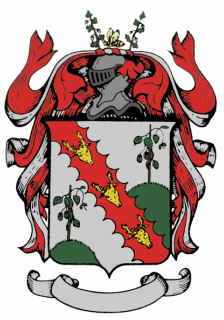 Arms granted 1829 to Thomas Hugh Boorman
Arms granted 1829 to Thomas Hugh Boorman I downloaded a copy of this Burkes General Armory reference from Google Books and found an entry for Boorman. The description provided is very similar, although it is even more cryptic as it is further abbreviated. Unfortunately the Burke's book does not provide a drawing of this coat of arms. So what does this Boorman coat of arms really look like? According to other researchers who know more about translating these descriptions than I, the coat of arms displayed here seems to match the above description. Our son colorized it using the conventions found on the International Heraldry site. The critical parts are the shield, and the very top "crest" where the bee and oak branches are displayed. The helmet and surrounding banners and embellishments are apparently open to artistic license. So other variations of this crest may also be valid as long as they match the official description.
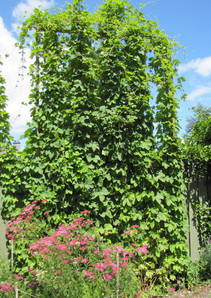 Terry's home grown Cascade hops
Terry's home grown Cascade hops However, it is now quite clear that arms are granted to individuals and their direct male descendants, and not to everyone with the same surname. Burkes did mention that, in 1829, the above described arms was "granted to Thomas Hugh Boorman, Esquire of East Peckham, County Kent". This is the same name as mentioned in the 1899 book of lineages mentioned above, which stated: "Thomas Hugh Boorman, son of William Boorman of Lamberhurst, was of East Peckham, Kent and Brixton, Surrey, died 1859. Arms granted to him 1829, and the descendants of his father. Married Margaret Martyr. s.p. [without issue]" The book's chart also lists John Hicks Boorman as a brother to this Thomas, who was therefore also a son of William. Although all of these individuals were Terry's distant cousins, Terry is not a direct male descendant of this particular family, so his line does not have the official right to display these arms as their own.
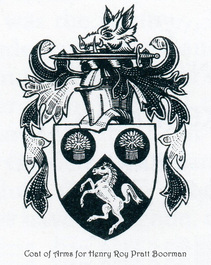 Arms granted in 1939 to Henry R P Boorman
Arms granted in 1939 to Henry R P Boorman I have been unable to find the official description of this later grant of arms, but this black and white graphic shows the one actually used in his publications. It includes the white horse of Kent on the shield, and a boar's head and sword in the crest. So perhaps he believed the legend that one of our early ancestors was named as the "boar man" after slaying a wild boar? This coat of arms is obviously very different from the earlier one.
While neither of these coats of arms apply directly to us, they are connected to side branches in our family tree, and of much interest to the overall story of the Boormans of Kent England.
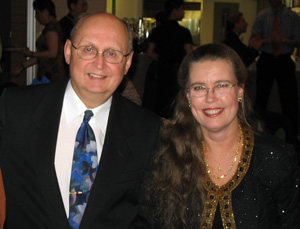
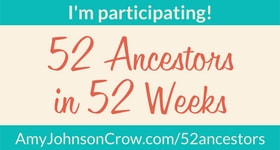
 RSS Feed
RSS Feed
